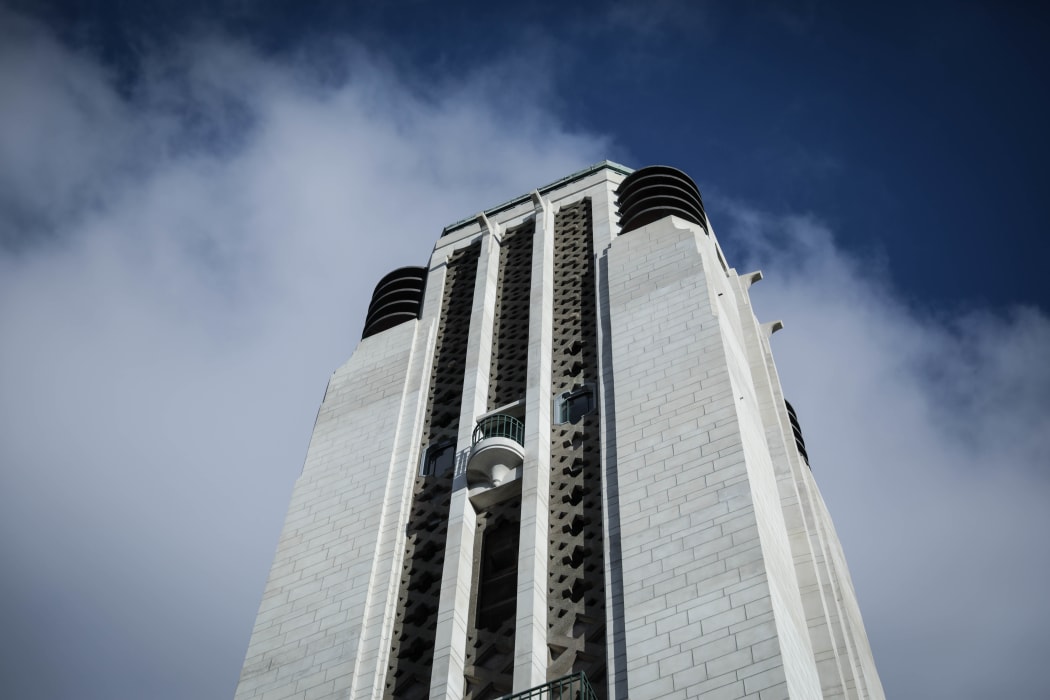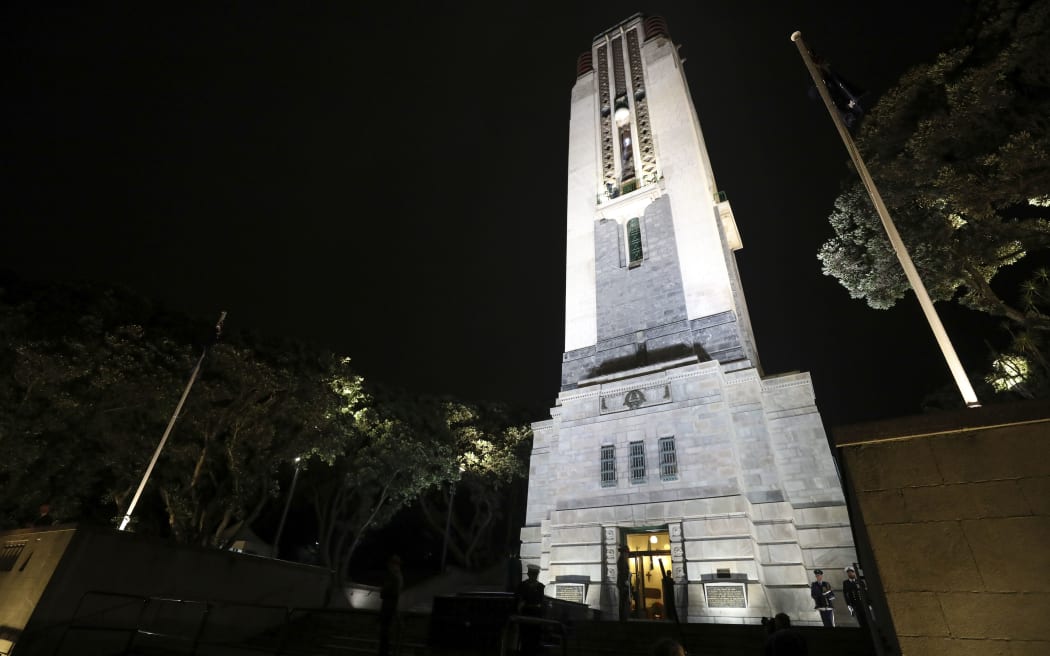The largest bell in the Carillon tower at the National War Memorial in Wellington - the 12.5 tonne Peace (Rangimārie) bell - is on a beam at risk of buckling in an earthquake.

The Carillon tower. Photo: RNZ / Rebekah Parsons-King
The tower also has a third part that is earthquake-prone.
This was revealed in a new detailed seismic assessment report.
The third weakness renders the upper part of the country's most prized tower quake-prone - in addition to the lower part, and the bell frames.
The belated assessment of weaknesses - that were first noted nine years ago - comes two years after the completion of strengthening work costing $3 million that closed the tower and Hall of Memories behind it for long periods.
According to the new assessment, "the bells and bell frames present a potential significant life safety hazard" and the frame could fail in various ways, in a tower that is near the Wellington Fault and 45m high.
The Peace (Rangimārie) bell is the largest such bell in the Southern Hemisphere.
Bells or "other material" might fall on someone in the Carillon foyer, the Ministry for Culture and Heritage warned yesterday.
Dignitaries and the public used the foyer for almost two years from when the tower reopened in mid-2018 to February this year when it was closed again.
The ministry was first warned of the risk from the bells in a "simplified assessment" in 2011 by the same engineers, Dunning Thornton.
The firm told the ministry to do a full assessment of the bell frame, but it did not till now.
Full assessment recommended
This new report, based on tighter assessment rules and much greater computing power, says the beam supporting the Peace bell could buckle - it rates 15 percent of the quake code.
Furthermore, three other parts of the two bell frames, at levels five and seven, might also buckle.
The bell frame was "very sensitive" to movement in the tower, which can rock in a quake because it is not fixed to its foundations which is believed to be a good thing for reducing stress on the tower itself.
In addition, reinforced concrete piers between level five and six have now been found to be 30 percent of the New Building Standard - under the 34 percent threshold.
Altogether, the tower is a Grade E or "very high risk building": It poses a risk to occupants more than 25 times greater than at a new building in the same spot.
It is a category one historic place.
The engineers have also found two other secondary elements are on the borderline of quake-prone:
- Precast concrete screens - decorative screens up the centre of the tower - would "begin to crush" at a 34 percent level of shaking with little to stop them falling
- The facade stonework
The Wellington City Council called the tower "sound as a bell" in 2018, when it knew it was earthquake-prone.
There was nothing to suggest the 45m high tower would fall on anyone outside, the ministry said yesterday, but added: "In the event of an earthquake people are advised to move away and drop, cover and hold".
The new report makes clear it is not a full re-assessment of the tower.
A full assessment must be completed "as part of any strengthening works", it said.
This presents at time problem: the ministry has less than years till deadline to fully, finally strengthen the tower - May 2022 - and without a full assessment, it does not know the extent of what it has to do.
This comes nine years after the Christchurch quake resulting in a Royal Commission replete with recommendations for improving seismic safety; four years after the 7.8-magnitude Kaikōura quake rang alarm bells for more than 80 concrete buildings in the capital, and led to the demolition of others.
The tower's concrete is weaker than assessed in 2011.
"The existing reinforced concrete structure requires ongoing repairs to corroding reinforcing," the new report said.
"Any strengthening works need to fit with the remaining life span of the concrete structure. The frequency and cost of repairs required to keep the structure sound will continue to increase over time, therefore a short-term solution may be more pragmatic.
"Alternatively, the strengthening works could present an opportunity to prolong the life of the structure."

The National War Memorial Carillon tower before the commencement of last year's dawn service. Photo: RNZ / Ana Tovey
Peer review underway
Even this new detailed assessment has yet to be peer-reviewed - a vital process as engineers frequently disagree with one another.
"The peer review is currently underway and we are expecting a response by the end of the month," the ministry said in a statement.
"The peer review is not expected to change the current seismic rating of the Carillon."
The ministry began six years of upgrades at the war memorial and tower in 2012.
This included strengthening the steel chevron braces in the upper part in 2012; but it did not strengthen the lower, despite being advised the lower must be substantially stronger than the upper, for safety.
In work between 2016 and 2018, it had the bell frame strengthened - but only part of it.
The ministry's chief executive has repeatedly declined an interview, which RNZ had advised would focus on the management of the project to date and hereon.
"No interviews are being given, however, you are welcome to send in your written questions," the ministry said.
In response to RNZ's written question asking whether a layperson's summary would be included of what it would take to fix the lower tower's weaknesses, it said: "The Detailed Seismic Assessment does not contain a layperson's summary."
Associate Minister for Arts, Culture and Heritage Grant Robertson has been approached for comment.





